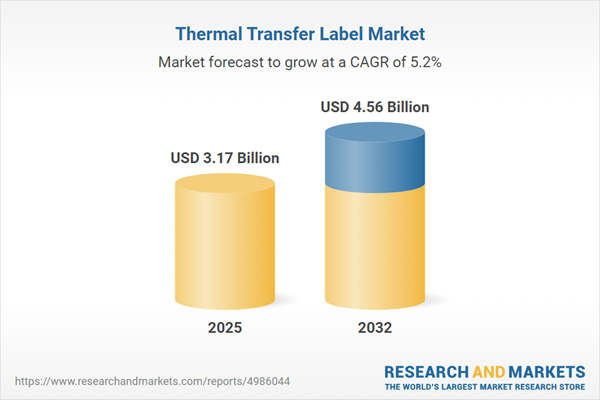Speak directly to the analyst to clarify any post sales queries you may have.
The thermal transfer label market is transforming as industries seek reliable, high-resolution labeling solutions that balance durability, compliance, and sustainability. This report offers actionable insights tailored for senior decision-makers needing clarity on technology trends, regulations, and strategic growth opportunities.
Market Snapshot of the Thermal Transfer Label Market
The thermal transfer label market grew from USD 3.03 billion in 2024 to USD 3.17 billion in 2025 and is expected to reach USD 4.56 billion by 2032, advancing at a CAGR of 5.23%.
Growth is fueled by the need for lasting, high-clarity labeling systems across sectors such as logistics, manufacturing, healthcare, and retail. Advanced printing technologies and evolving sustainability standards are shaping new market frontiers as organizations look to integrate traceability, compliance, and efficiency into their labeling strategies.Scope & Segmentation
- Material Types: Paper, synthetic, polyester, polyethylene, polypropylene
- Adhesive Types: Permanent, removable
- Label Widths: Greater than 6 Inch, up to 6 Inch
- Perforation Options: With perforation, without perforation
- Application Areas: Asset tracking, equipment tagging, inventory management, compliance labeling, price tags, shelf labels
- End User Industries: Food and beverage, healthcare, medical devices, pharmaceuticals, logistics and transportation, manufacturing, automotive, chemicals, electronics, retail and e-commerce
- Distribution Channels: Offline, online (company websites, third-party portals)
- Regional Coverage: North America, United States, Canada, Mexico, Latin America, Brazil, Argentina, Chile, Colombia, Peru, Europe, United Kingdom, Germany, France, Russia, Italy, Spain, Netherlands, Sweden, Poland, Switzerland, Middle East, United Arab Emirates, Saudi Arabia, Qatar, Turkey, Israel, Africa, South Africa, Nigeria, Egypt, Kenya, Asia-Pacific, China, India, Japan, Australia, South Korea, Indonesia, Thailand, Malaysia, Singapore, Taiwan
- Key Companies: 3M Company, Avery Dennison Corporation, Brady Corporation, CCL Industries Inc., CleanMark Labels, Coast Label Company, Consolidated Label Co., DNP Corporation, Domino Printing Sciences plc, HERMA GmbH, ID Technology LLC, Label World, Lintec Corporation, MPI Labels, Multi-Color Corporation, OMNI Systems, OMNI Systems LLC, Ricoh Electronics Inc., SATO Holdings Corporation, Skylark Labels, SWATI POLYPACK, Telepaper, Toshiba Tec Corporation, United Paper Inc., UPM-Kymmene Corporation, Zebra Technologies Corporation
Key Takeaways for Decision-Makers
- Thermal transfer label adoption is driven by rising traceability demands and tightening regulatory expectations in prominent industries.
- Technology advancements, such as enhanced printhead designs and resin ribbon innovations, improve both print quality and lifecycle durability for labels.
- Sustainability mandates are accelerating the use of biodegradable substrates and less petroleum-dependent ribbons, pushing companies to seek materials that support environmental goals without sacrificing performance.
- Digital integration, including IoT-enabled printing and cloud-based design systems, strengthens operational transparency and speeds up label adaptation to market or compliance shifts.
- Strategic partnerships, vertical integration, and mergers are enabling manufacturers to secure supply availability, attain cost control, and unlock new markets for intelligent labeling solutions.
- Regional strategies must address distinct regulatory frameworks, infrastructure dynamics, and local business models to realize scalable growth across the Americas, EMEA, and Asia-Pacific.
Tariff Impact
The 2025 United States tariff changes on specialty ribbons and synthetic substrates have required swift adjustments in supply chain strategies. Companies diversified supplier networks, invested in local production, and leveraged tariff-inclusive contracts to manage cost and delivery risks. The move also led downstream users to broaden service offerings and explore alternative materials, ensuring operational continuity amid fluctuating import pressures. Nearshoring and reshoring initiatives gained momentum as a response, offering logistics and duty advantages despite upfront expense.
Methodology & Data Sources
This report integrates robust secondary research—including industry publications, regulatory reviews, and public trade data—with extensive primary interviews from manufacturers, converters, end users, and distribution experts. Rigorous data triangulation, expert panels, and cross-validation underpin the analysis, ensuring each insight is grounded in empirical evidence and practical expertise.
Why This Report Matters
- Guides executives to make informed investments in material innovation, digital transformation, and multi-region strategies.
- Reveals practical actions for supply chain resilience, regulatory compliance, and future-proof product development.
- Enables benchmarking against top competitors, helping drive sustainable differentiation and operational efficiency.
Conclusion
The thermal transfer label market is evolving rapidly across technologies, applications, and geographic landscapes. Industry leaders that align strategies to sustainability, agility, and digital advancement will secure long-term growth and competitive distinction.
Additional Product Information:
- Purchase of this report includes 1 year online access with quarterly updates.
- This report can be updated on request. Please contact our Customer Experience team using the Ask a Question widget on our website.
Table of Contents
3. Executive Summary
4. Market Overview
7. Cumulative Impact of Artificial Intelligence 2025
Companies Mentioned
The companies profiled in this Thermal Transfer Label market report include:- 3M Company
- Avery Dennison Corporation
- Brady Corporation
- CCL Industries Inc.
- CleanMark Labels
- Coast Label Company
- Consolidated Label Co.
- DNP Corporation
- Domino Printing Sciences plc
- HERMA GmbH
- ID Technology, LLC.
- Label World
- Lintec Corporation
- MPI Labels
- Multi-Color Corporation
- OMNI Systems
- OMNI Systems LLC.
- Ricoh Electronics, Inc.
- SATO Holdings Corporation
- Skylark Labels
- SWATI POLYPACK
- Telepaper
- Toshiba Tec Corporation
- United Paper Inc.
- UPM-Kymmene Corporation
- Zebra Technologies Corporation
Table Information
| Report Attribute | Details |
|---|---|
| No. of Pages | 186 |
| Published | November 2025 |
| Forecast Period | 2025 - 2032 |
| Estimated Market Value ( USD | $ 3.17 Billion |
| Forecasted Market Value ( USD | $ 4.56 Billion |
| Compound Annual Growth Rate | 5.2% |
| Regions Covered | Global |
| No. of Companies Mentioned | 27 |









